Dear Athlete,
In this series of videos I am going to reveal to you how your body generates 5 rotational forces, or body torques, around your spinal column to help you run faster.
These 5 rotational forces are created from powerful muscle contractions found within your 1) right leg, 2) left leg, 3) right arm 4) left arm and 5) torso. See Figure 1.
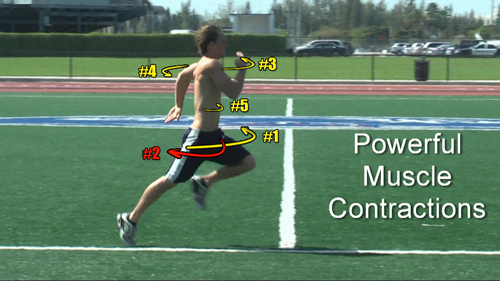 Figure 1. 5 Rotational Forces to Run Faster.
Figure 1. 5 Rotational Forces to Run Faster.
And as an athlete, you absolutely must know about these 5 rotational forces because if you fail to train even just one of them then you are likely under-training when it comes to running speed. And if you are under-training then it is safe to say that you will not run as fast as you WERE meant to.
So I want to encourage you to watch the rest of this FIRST video because not only will you learn about the first body torque involved in running faster, but many of you are also going to start to see just how limited and perhaps just how narrow your speed training focus currently is. See Figure 2.
 Figure 2. Narrow Speed Training Focus.
Figure 2. Narrow Speed Training Focus.
And my hope for you is that once you see this this you will want to watch all of these videos so that you can tap in to your true running speed potential.
Now if you are ready, let’s begin.
What is Torque?
Torque is defined as any force that causes rotation and for our purposes here, we only need to concern ourselves with the direction of this rotation which can either be clockwise or counterclockwise. See Figure 3.
 Figure 3. Torque is a force that causes rotation.
Figure 3. Torque is a force that causes rotation.
So, for example, if we are looking at the face of a clock and apply a force to the minute hand in this direction, it will cause it to rotate in the clockwise direction. See Figure 4.
 Figure 4. Clockwise Torque.
Figure 4. Clockwise Torque.
And similarly, if we apply force in this direction, it will cause it to rotate in the ccw direction. See Figure 5.
 Figure 5. Counterclockwise Torque.
Figure 5. Counterclockwise Torque.
That’s easy enough right? So with that in mind, let’s go ahead and see if we can identify our first body torque.
Torque #1
In this figure we are going to draw just three simple lines on our athlete so we can start to envision where these body torques will act on the body. One line represents the spinal column as well as the center of the body where all 5 of these rotational forces will try and turn the body around. Another line is drawn across the shoulders and represents where the arms are attached and where they will try and rotate the upper body around the spinal column, and another line is drawn across the hips and represents where the legs are attached to the pelvis and is where they will try and rotate the lower body around the spinal column. See Figure 6.
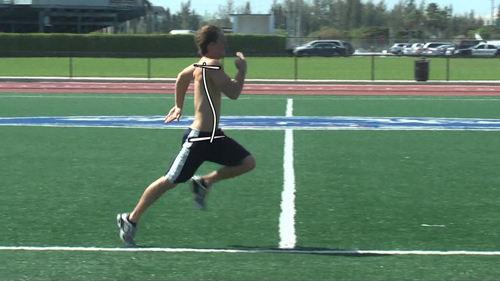 Figure 6.
Figure 6.
Now the first body torque that we are going to talk about will come from the right leg through the right hip. Since the right leg is on the ground behind our athlete pushing forward, we know then that a force, relatively speaking with regards to direction, will push the right hip going forward. See Figure 7.
 Figure 7. Force pushing through right hip.
Figure 7. Force pushing through right hip.
Now if this were the only force acting on the body, the question then is this. Which direction, if any, will it cause our athlete’s hips to turn?
Well the first thing to take notice of here is that, with respect to the spinal column, the force is coming from the right hip which is displaced to the right of it.
So we know that it has to rotate the body in one direction or the other. Because, the only way it wouldn’t cause the body to rotate would be if it were directly in line with the spinal column itself, which is simply not possible. See Figure 8.
 Figure 8. No rotation caused by force in the center of the spine.
Figure 8. No rotation caused by force in the center of the spine.
So we know it has to rotate, but again, which direction? Well, if we imagine this force continuing in the same direction, forward through the right hip, we can then see that it will produce a counterclockwise torque AROUND THE SPINAL COLUMN as seen by the direction of this arrow. See Figure 9.
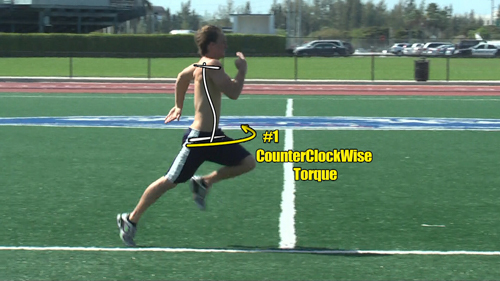 Figure 9. Torque #1 is Counterclockwise.
Figure 9. Torque #1 is Counterclockwise.
So there’s the first of five body torques to help you run faster and the muscle groups in your lower extremity responsible for this torque are primarily the hip extensors, or glutes/hams as they are often referred to, the knee extensors, or quads, and the ankle plantarflexors, or calf muscles. See Figure 10.
 Figure 10. Glutes/Hams, Quads, Calves for Torque #1.
Figure 10. Glutes/Hams, Quads, Calves for Torque #1.
Now if you stop and think about what exercises you might do to help you train these muscle groups you will likely come up with many of them seen in this list. See Figure 11.
 Figure 11. Torque #1 Exercises.
Figure 11. Torque #1 Exercises.
Most of them target the glutes/hams, some target the quads and some the calf muscles and some of them target all three at the same time.
Now before we go any further, I want to say that I like all of these exercises in this list and I highly recommend them for any athlete looking to run faster. In fact, you could even say that this list of exercises is foundational to many training routines and are largely responsible for helping you get a quick first step, helping to improve reaction time, helping to improve running speed, improve running stride, improve turnover rate, increasing sprinting speed and much more.
But what I find interesting about it and the muscles that are targeted, is that not only do many athletes choose specifically from it to help them run faster, any exercises they do outside of this list to help them get quicker will more often than not, still only target these same three muscle groups and again, that’s the glutes/hams, quads and calf muscles.
So while they may look to create a variety in their routines to help them find that elusive speed training breakthrough that they’ve always wanted, they usually never seem to break away from training any one or more of these three muscle groups. See Figure 12.
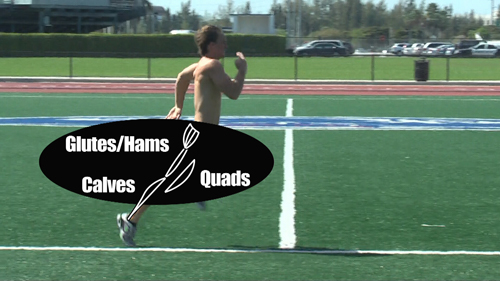 Figure 12.
Figure 12.
And the challenge those athletes will face, the challenge that you are likely facing today as you look to get faster, is that if you continue to focus or limit your speed training to just the glutes/hams, quads, and calves, you will be missing the training necessary that these other 4 torques demand for you to run faster because they each involve a completely a different set of muscles. See Figure 13.
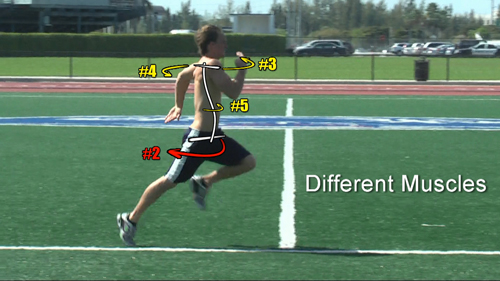 Figure 13.
Figure 13.
Furthermore, this first toque that is generated by your glutes and hamstrings, the quads and calves needs to be offset by one or more of these other 4 torques. See Figure 14.
 Figure 14.
Figure 14.
In other words, your body must produce some sort of torque in the opposite direction to counterbalance this torque, otherwise you will have a hard time running in a straight line. And if you don’t have the necessary strength in other muscles to counteract the powerful glutes/hams, you won’t be able to take full advantage of their powerful strength.
So, that leads us to the second body torque involved in running, one that is necessary to counteract or counterbalance this first torque, and that is the subject of our next video. See Figure 15.
 Figure 15. Torque #2, Counteracting Torque.
Figure 15. Torque #2, Counteracting Torque.

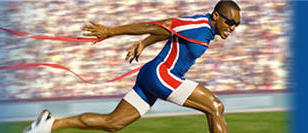

Leave a Reply
You must be logged in to post a comment.